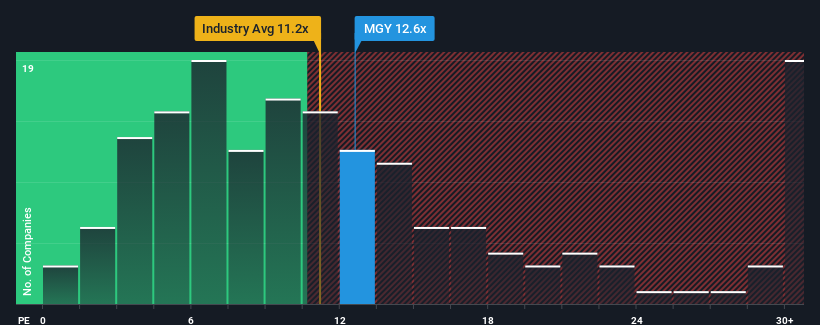- United States
- /
- Oil and Gas
- /
- NYSE:MGY
Many Still Looking Away From Magnolia Oil & Gas Corporation (NYSE:MGY)
With a price-to-earnings (or "P/E") ratio of 12.6x Magnolia Oil & Gas Corporation (NYSE:MGY) may be sending bullish signals at the moment, given that almost half of all companies in the United States have P/E ratios greater than 18x and even P/E's higher than 32x are not unusual. Nonetheless, we'd need to dig a little deeper to determine if there is a rational basis for the reduced P/E.
With earnings that are retreating more than the market's of late, Magnolia Oil & Gas has been very sluggish. The P/E is probably low because investors think this poor earnings performance isn't going to improve at all. You'd much rather the company wasn't bleeding earnings if you still believe in the business. If not, then existing shareholders will probably struggle to get excited about the future direction of the share price.
See our latest analysis for Magnolia Oil & Gas

How Is Magnolia Oil & Gas' Growth Trending?
There's an inherent assumption that a company should underperform the market for P/E ratios like Magnolia Oil & Gas' to be considered reasonable.
If we review the last year of earnings, dishearteningly the company's profits fell to the tune of 53%. However, a few very strong years before that means that it was still able to grow EPS by an impressive 319% in total over the last three years. So we can start by confirming that the company has generally done a very good job of growing earnings over that time, even though it had some hiccups along the way.
Looking ahead now, EPS is anticipated to climb by 9.2% per year during the coming three years according to the twelve analysts following the company. Meanwhile, the rest of the market is forecast to expand by 9.9% per year, which is not materially different.
In light of this, it's peculiar that Magnolia Oil & Gas' P/E sits below the majority of other companies. Apparently some shareholders are doubtful of the forecasts and have been accepting lower selling prices.
The Key Takeaway
We'd say the price-to-earnings ratio's power isn't primarily as a valuation instrument but rather to gauge current investor sentiment and future expectations.
Our examination of Magnolia Oil & Gas' analyst forecasts revealed that its market-matching earnings outlook isn't contributing to its P/E as much as we would have predicted. There could be some unobserved threats to earnings preventing the P/E ratio from matching the outlook. At least the risk of a price drop looks to be subdued, but investors seem to think future earnings could see some volatility.
Don't forget that there may be other risks. For instance, we've identified 2 warning signs for Magnolia Oil & Gas that you should be aware of.
You might be able to find a better investment than Magnolia Oil & Gas. If you want a selection of possible candidates, check out this free list of interesting companies that trade on a low P/E (but have proven they can grow earnings).
New: Manage All Your Stock Portfolios in One Place
We've created the ultimate portfolio companion for stock investors, and it's free.
• Connect an unlimited number of Portfolios and see your total in one currency
• Be alerted to new Warning Signs or Risks via email or mobile
• Track the Fair Value of your stocks
Have feedback on this article? Concerned about the content? Get in touch with us directly. Alternatively, email editorial-team (at) simplywallst.com.
This article by Simply Wall St is general in nature. We provide commentary based on historical data and analyst forecasts only using an unbiased methodology and our articles are not intended to be financial advice. It does not constitute a recommendation to buy or sell any stock, and does not take account of your objectives, or your financial situation. We aim to bring you long-term focused analysis driven by fundamental data. Note that our analysis may not factor in the latest price-sensitive company announcements or qualitative material. Simply Wall St has no position in any stocks mentioned.
About NYSE:MGY
Magnolia Oil & Gas
An independent oil and natural gas company, engages in the acquisition, development, exploration, and production of oil, natural gas, and natural gas liquids reserves in the United States.
Excellent balance sheet and good value.
Similar Companies
Market Insights
Community Narratives




